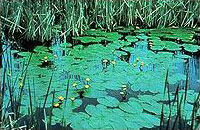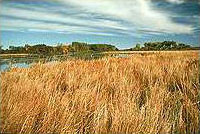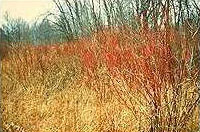Wetland types
Scientists distinguish dozens of wetland types, characterized by vegetation, soil type and degree of saturation or water cover. Some of the more prominent types found in Wisconsin are listed below.

-
Aquatic bed
- Plants growing entirely on or in a water body no deeper than 6 feet. Plants may include pondweed, duckweed, lotus and water–lilies.

- Marshes
- Characterized by standing water and dominated by cattails, bulrushes, pickerelweed, lake sedges and/or giant bur–reed.

Sedge or "wet" meadows
- These wetlands more often than not have saturated soils rather than standing water. Sedges, grasses and reeds are dominant, but may also have blue flag iris, marsh milkweed, sneezeweed, mint and several species of goldenrod and aster.

Scrub/shrub
- These areas, which include bogs and alder thickets, are characterized by woody shrubs and small trees such as tag alder, bog birch, willow and dogwood.

Forested
- These areas, which include bogs and forested floodplain complexes, are characterized by trees 20 feet or more in height such as tamarack, white cedar, black spruce, elm, black ash, green ash and silver maple.
More information
- Endangered Resources wetlands communities page – detailed information on wetland communities found within Wisconsin
- Wetland Plants and Plant Communities of Minnesota and Wisconsin – publication by Steve Eggers and Donald Reed
Relationships
Three broad categories describe the relationship of Wisconsin wetlands to other surface waters:
- Lacustrine wetlands are associated with lakes.
- Riverine wetlands are found along shores of rivers and streams.
- Palustrine wetlands are not associated with lakes, rivers or streams.
